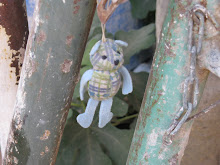While here in
Our first stop was the mosque; I have never been in a mosque before, so I was very interested to see what was on the inside. We had to take off our shoes before entering. I also noticed a large stone circle with water spigots radiating from it, I later learned that even if you’re not Muslim, you’re supposed to wash your hands and feet before entering. Being the well-informed American that I was, I skipped the spigots and entered the mosque in my socks.
The first room we entered was the room where I assumed that Muslims would worship and pray. The floor was covered with a hodgepodge of carpets, some with religious imagery. The mosque had a very high ceiling and while I was taking pictures I heard my friend Zaina say, “There are birds in here!” Zaina comes from a Muslim background, and she told us that one superstition is that birds inside a building bring very bad luck. There were three birds in this mosque, but I wasn’t too worried that the ceiling would cave in; the mosque had already thrice experienced some damage to its status, or bad luck as it were.
A door led from the prayer room into another room with a bed in the center. The bed was protected by an ornate gold colored barrier. This was the tomb that the mosque was built around. I learned that originally the body was fabled to be that of Mohamed’s mother and had enjoyed a great deal of popularity. Later the tomb was said to be only that of Mohamed’s aunt, naturally it decreased in popularity, but the final de-ranking of the tomb is what I think made our bus of students the only visitors to the mosque that day. The tomb’s resident was again questioned, the title of aunt retracted, and replaced, with that of Mohamed’s wet-nurse.
Despite the downgrades to the mosque’s title, I was impressed by the reverence given to the holy place. There was a respect to God that was requested by the mosque, that’s why we needed to take off our shoes and wash ourselves. Though my cultural ignorance prevented me from being properly respectful, I did appreciate that the Muslim culture held a reverence for God and also an openness that allowed others to see it.
Our next visit was to a Greek Orthodox church that housed the Tomb of Lazarus, a friend of Jesus whom He had resurrected. Like the mosque, the church requested some reverence and respect before we entered. The women had to cover their legs, and it was preferable that the men covered their legs as well, though it seemed less important for guys. I was about to dawn a long skirt, but there weren’t enough, so I gave mine to a female student, and then sporting a pair of shorts, I briskly walked into a tomb housing a man historical to my own faith.
Greek Orthodox churches are unique because they have a large amount of old and beautiful Christian artwork displayed in them, this church was no different in that respect. The difference in this church was the small stone staircase that led to the tomb.
The tomb was cramped and strange ornaments hung above the stone casket. I squeezed past a few people to get a closer look. There were two caskets, and both were open on one end, one looked like it had been broken open. I assumed that the reason for two caskets was because one had held Lazarus’s wife, but I did not know until later why the tombs were open and had no bodies.
I later discovered that the remains of Lazarus had been moved in 898 A.D. to
Lazarus was buried twice, died twice, and was moved twice after he was dead. All this moving around is a bit funny in retrospect. But I suppose Lazarus didn’t mind getting a second chance at everything, such is the opportunity provided by a resurrection.
His displacement to









